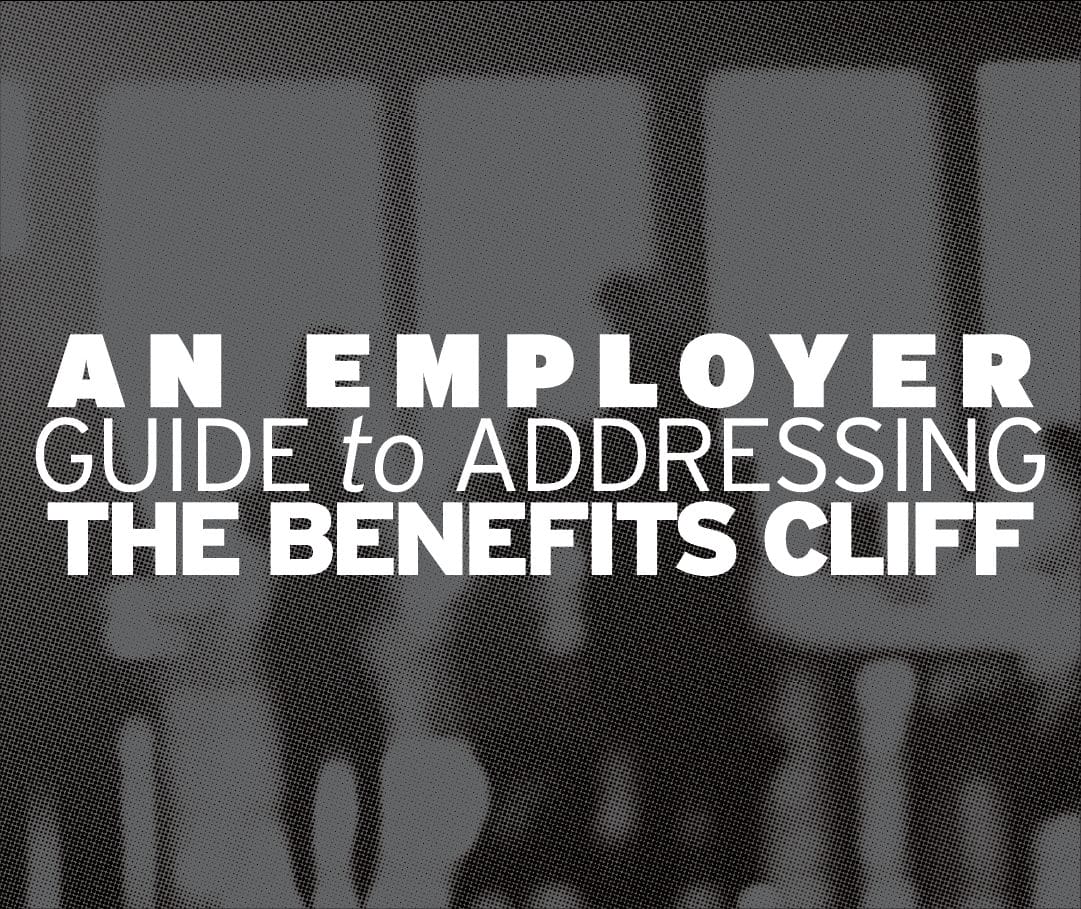An Employer Guide to Addressing the Benefits Cliff
 The Benefits Cliff hurts employees and employers alike by keeping hard-working individuals down and imposing barriers on growth. As we work to address this challenge with initiatives at the local, State, and Federal levels, in the short-term employers can take matters into their own hands to support their employees. In situations where it is not possible for employers to offer wage increases that completely offset the loss of Net Financial Resources associated with lost benefits, there are still several ways to support employees facing this cliff:
The Benefits Cliff hurts employees and employers alike by keeping hard-working individuals down and imposing barriers on growth. As we work to address this challenge with initiatives at the local, State, and Federal levels, in the short-term employers can take matters into their own hands to support their employees. In situations where it is not possible for employers to offer wage increases that completely offset the loss of Net Financial Resources associated with lost benefits, there are still several ways to support employees facing this cliff:
- Educate Employees
Educating employees about the benefits cliff is an important way to empower them to make the decisions that are best for their financial situation. Employers should ensure workers understand what benefits may be forfeited when they accept a raise or take on additional hours. It’s equally as important to be supportive and understanding of the conclusion they arrive at to maximize their financial wellbeing. Sharing a Benefits Cliff Calculator, such as this one created by the Federal Reserve Bank of Atlanta and hosted by the Buffalo Niagara Partnership, can help make this more clear. Additionally, you can provide information about refundable tax credits, which can be very valuable and have gradual phaseouts and help your employees understand options for free or affordable tax filing assistance to help them claim these credits.
- Offer Flexible Scheduling
Childcare is an area that is most severely impacted by the benefits cliff. When possible, offering flexible scheduling to employees may help them balance their responsibilities at work with their caregiving responsibilities at home. This flexibility helps to prevent additional, debilitating expenses for employees leading to increased retention and work output. Furthermore, the US Chamber of Commerce notes that allowing employees to have a greater degree of control over the number of hours they work may allow them to avoid a benefits cliff entirely.
- Offer Income-Based Health Insurance Premiums
For workers leaving Medicaid and enrolling in employer sponsored health insurance, any premium they will pay acts as a benefit cliff. An income-based approach to health insurance allows for lower-paid employees to contribute a smaller amount to maintain their health coverage.
- Support Paid Family Leave
New York Paid Family Leave is insurance that is funded by employees through payroll deductions. Each year, the Department of Financial Services sets the employee contribution rate to match the cost of coverage. Paid family leave time can help employees struggling with providing care for young children under 12 months of age. This includes situations where they are either unable to afford childcare or unable to find openings for third-party child care. New York’s Paid Family Leave program provides employees with job protection, continued health insurance, and other benefits to help them land on their feet while dealing with uncertainty at home.
- Offer Financial Wellness Benefits
Creating an Employee Financial Wellness Program (EFWP) is a way of more directly supporting employees’ finances. These programs can include a number of different financial wellness benefits. Examples include debt management services, digital apps to help workers access and use public and private benefits, financial coaching and counseling, emergency savings programs, and employee assistance funds for emergencies, including a loss of public benefits.
- Advocate for Systemic Change
Employers should not be expected to bear the burden of this systemic issue, as many are facing their own set of short- and long-term issues a that hurt bottom-line growth. Greater Rochester Chamber supports Senate Bill 2144, legislation introduced by Senator Roxanne Persaud that seeks to lessen the adverse impacts of the benefits cliff by providing a six-month income disregard following a wage increase to allow for the continuation of the same public benefits while employees adjust to their new financial situation. For employers looking to make a difference, we invite you to express your concerns over the Benefits Cliff directly with the NYS Assembly. Greater Rochester Chamber has provided a template for other concerned businesses and organizations to send directly to Speaker Carl Heastie. You can download and send the template below to make your voice heard:
From businesses to workforce entities to policymakers, awareness is the critical first step in overcoming the challenges of benefits cliffs. We hope you will learn more about this issue and share the information with others to help create a widespread awareness. Learn more about the benefits cliff and what’s being done about it at GreaterRochesterChamber.com/Benefits-Cliff.
